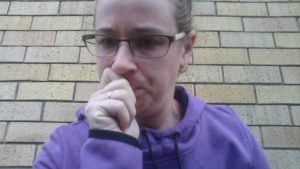Literature Review:
WORKING WITH STUDENTS WITH CHALLENGING BEHAVIOURS
Elizabeth Saunders
www.twitter.com.au/e_r_saunders
CONASTA 65 presentation July 2016 (video)
Introduction
Challenging behaviours are a key issue which continue to confront schools. Effective management of this complex, multifaceted issue is crucial from an inclusive and human rights perspective. Many stakeholders are involved and the consequences of (mis)management are far reaching. Challenging behaviours are defined as those
“of such intensity, frequency or duration as to threaten the quality of life and/or the physical safety of the individual or others, and which is likely to lead to responses that are restrictive, aversive or result in exclusion” (Royal College of Psychiatrists (RCP) et al., 2007 in (Evers & Pilling , 2012)
Intense and severe challenging behaviours such as violent outbursts can be very disruptive and a barrier to learning; however, seemingly inconsequential behaviour (such as calling out or being out of seat) can be just as problematic when occurring with high frequency (Alter, Walker, & Landers, 2013; Dunlap & Fox, 2007; Dunlap, Sailor, Horner, & Sugai, 2009; Katsiyannis, Conroy, & Zhang, 2008).
The term ‘challenging behaviours’ is a critical and deliberate change from terms such as ‘abhorrent’, ‘abnormal’ or ‘problem’, although the latter is still used at times. It views challenging behaviours as a mismatch between the behaviour and the environment, rather than blaming the behaviour, and usually by extension the student, for the problem (Dunlap et al., 2009; Lohrmann, Forman, Martin, & Palmieri, 2008).
Addressing challenging behaviour is important to education because all students have a right to an education, and students and staff all have a right to be safe. Challenging behaviours can be very stressful for students, peers, teachers and other staff and families alike. (Bambara, Goh, Kern, & Caskie, 2012; Dunlap & Fox, 2007; Goh & Bambara, 2012; O’Brennan, Bradshaw, & Furlong, 2014; Preece, 2014; Quesenberry, Hemmeter, & Ortrosky, 2011).
Development and maintenance of challenging behaviour
The literature identifies a variety of generally interrelated factors which contribute to the development and maintenance of challenging behaviours.
There is no broad consensus in the literature about specific statistics, but some groups of students are more likely to demonstrate challenging behaviours. These overwhelmingly include students with disabilities and learning difficulties, students with emotional and behavioural disorders or mental health conditions, boys, and to a lesser extent, students undergoing puberty, and in some instances, students from low socioeconomic backgrounds or families with a history of anti-social behaviour (although the literature does not have consensus on this in an Australian context) (Allan Allday, Neilsen-Gatti, & Hudson, 2013; Barroso, et al., 2008; Brown & Conroy, 2011; Bull, Oliver, Callaghan, & Woodcock, 2015; Cameron, Connor, Morrison, & Jewkes, 2008; Conroy, Stichter, Daunic, & Haydon, 2008; Dunlap & Fox, 2007; Felstrom, Mulryan, Reidy, Staines, & Hillery, 2005; Hemphill, et al., 2010a; Hemphill, et al., 2010b, Kelly, Carey, McCarthy, & Coyle, 2007; Koristsas & Iacono, 2012; Ling & Mak, 2011; McKenna, Flower, Kyung Kim, Ciullo, & Haring, 2015; Voorhees, Walker, Snell, & Smith, 2013; Westling, 2010).
Perceived and actual lack of skills and/ or support of teachers, school and parents can also contribute to the maintenance of challenging behaviours by inadvertently rewarding and maintaining them. (Allan Allday et al., 2013; Dunlap & Fox, 2007, Dunlap et al., 2009; Ling & Mak, 2011; Preece, 2014; Quesenberry et al., 2011; Voorhees et al., 2013; Westling, 2010).
The development and maintenance of challenging behaviour is complex and multifaceted. Factors which may contribute to causing challenging behaviours include behaviour as communication (Brown & Conroy, 2011; Koristsas & Iacono, 2012; Ling & Mak, 2011; Michail, 2011; Nemeth & Brillante, 2011), academic and/or social skills deficit (Brown & Conroy, 2011; Koristsas & Iacono, 2012; McKenna et al, 2015; Martella & Marchand-Martella, 2015), physiological or psychological conditions (Koristsas & Iacono, 2012; Michail, 2011), relationships (or lack thereof) (Furlong, Sharkey, Quirk, & Dowdy, 2011) and operant conditioning and reinforcement (Dunlap et al., 2008; Koristsas & Iacono, 2012). In most instances, challenging behaviour can be attributed to a complex combination of some or all of these factors (Koristsas & Iacono, 2012).
Undeniably, the most significant factor is operant conditioning and reinforcement as it interacts with all components and (generally unintentionally) rewards or maintains the challenging behaviour. (Dunlap et al., 2008; Dunlap et al., 2009) For example, a student who experiences anxiety about being required to complete an academic task may engage in challenging behaviour which results in his/her exclusion from the class, thereby achieving the desired outcome or purpose, that is, avoiding the task (eg McKenna et al., 2015).
Effective strategies that can be used by schools and teachers to prevent or reduce challenging behaviours
Before effective strategies are considered, it is relevant to address ineffective strategies which dominate school culture; that is, punitive and exclusionary methods. The research continually demonstrates that they are not effective as they do not address the cause of the behaviour or equip students to replace the challenging behaviours with more appropriate ones and indeed they often cause more harm than good (Carnett, et al., 2014). Because punitive and exclusionary strategies are so entrenched in school culture and in the attitudes of many teachers and parents, they are still widely use despite the total lack of empirical or ethical support (Dunlap et al. 2008; Dunlap et al., 2009; Michail, 2011; Milleia & Petersena; Voorhees et al., 2013; Wilhite, Braaten, Frey, & Wilder, 2007).
A far more effective approach is Positive Behaviour Support (PBS). PBS was developed in the 1980s from Applied Behaviour Analysis (ABA) (Dunlap et al., 2008; Dunlap et al., 2009; Michail, 2011). It is a human rights based, person centred approach which acknowledges and understands the factors which contribute to challenging behaviour and offers useful, empirically supported methods to reduce or prevent them (Devlin, Healy, Leader, & Hughes, 2010; Goh & Bambara, 2012; Preece, 2014). The aim of PBS is to facilitate improved quality of life for the person with challenging behaviour and then, by extension, those around him/her and when implemented well is very effective under a wide range of circumstances (Dunlap & Fox, 2007; Freeman, et al., 2015; Goh & Bambara, 2012; Muscott, Mann, & LeBrun, 2008; Voorhees et al., 2013; Westling, 2010). As well as reduction or prevention of students’ challenging behaviour, schoolwide BS programs have been shown to effectively improve outcomes for teachers’ well being and reduce burn-out (Ross, Romer, & Horner, 2012).
With its origins in ABA, PBS recognises that each behaviour has an antecedent, the behaviour itself, and the consequence. (Dunlap et al., 2008; Dunlap et al., 2009). The core features are
(a) application of research-validated behavioral science; (b) integration of multiple intervention elements to provide ecologically valid, practical support; (c) commitment to substantive, durable lifestyle outcomes; and (d) implementation of support within organizational systems that facilitate sustained effects (Carr et al., 1994, 2002; Durand, 1990; Horner et al., 1990; Sugai et al., 2000 in Dunlap, Sailor, Horner, & Sugai, 2009)
By observing a student’s behaviour in the ecological context of its precedent and consequence, a greater understanding of both its purpose and how it is being reinforced can be gained which allows changes to be made to intervene and support the student. This may be done by altering or avoiding particular triggers which may precede an event, responding to the student’s communication in a more appropriate way or helping the student to acquire alternate ways to achieve the intended purpose of the behaviour (Brown & Conroy, 2011).
Adequate and appropriate training and support for teachers is essential to implementing PBS and is largely lacking. (Allan Allday et al., 2013; Kelly et al., 2007; Ling & Mak, 2011; Prather-Jones, 2011; Preece, 2014; Quesenberry et al., 2011; Voorhees et al., 2013; Westling, 2010). Effective implementation of PBS also often requires a fundamental shift in attitudes and values and this too can be fostered through increased professional development and support for teachers and schools (Alter et al., 2013; Ling & Mak, 2011; Michail, 2011).
A comparison between schoolwide positive behaviour supports and positive behaviour supports that are planned and implemented for individual students
When PBS was first used in schools it was highly ineffective and inefficient. The resources required to implement detailed plans in the context of a busy classroom were astronomically out of reach and inefficient. A three tiered approach is a far more efficient and pragmatic approach (Dunlap et al., 2009; Bradshaw, Mitchell, & Leaf, 2009).
Tier One supports apply generally to all students and teachers and consist of consistent, appropriate and respectful rules with accompanying accommodations. Tier Two requires more support and is appropriate for those students who require somewhat more intensive intervention. Tier Three interventions are suitable for students who have challenging behaviour which has no responded to the first two tiers; it is very time and resource intensive and provides a high level of support (Brown & Conroy, 2011; Dunlap et al., 2009).
Key features for the success of schoolwide programs are
(a) team-based implementation, which consists of a representative schoolwide team that is organized and engages in problem solving and data-based decision making; (b) administrative leadership, which consists of consistent public support and active involvement in schoolwide team planning; (c) documented commitment to the education of all students and to improving the climate of the school; (d) adequate personnel and time for the planning and implementation of SWPBS; (e) budgeted support for activities associated with team planning, staff development, and necessary materials; and (f) information-system development for data management. (Lohrmann et al., 2008)
Schoolwide approaches are more likely to succeed at a district/ state level if there is leadership and funding from governing bodies, capacity for local professional development, behavioural expertise and evaluation capacity (Horner, et al., 2014). School personnel often demonstrate reluctance or resistance to adopt universal behavioural supports due to lack of leadership, not perceiving the changes as worthwhile (particularly if the connection between behaviour and academic achievement was not appreciated), a perceived hopelessness about change, or if the staff are lacking in relevant skills (Lohrmann et al., 2008). Staff are more likely to see the benefits of more intensive interventions. Philosophically difference values and beliefs are also a source of staff resistance (Lohrmann et al., 2008). There is some concern about the potential for this to lead to students internalising problems (McIntosh, Ty, & Miller, 2014) but more work needs to be done in this area. Barriers to implementing individualised plans for also included those related to beliefs, time and training (Bambara et al., 2012).
Intensive individual PBS plans would be conducted with a period of observation then meeting with stakeholders to discuss appropriate supports. Whilst the team of professionals and family create strength working together, difficulty in creating time to regularly meet often impedes effectiveness (Dunlap & Fox, 2007; Goh & Bambara, 2012).
Conclusion
In summary, the key messages from the literature are that challenging behaviours
- are an important issue facing schools, teachers, students and families
- challenging behaviours arise from a conflict between the student’s behaviour and the environment rather than a flaw with the student
- challenging behaviours occur and are maintained by complex interactions including reinforcement
- are ineffectively addressed by punitive measures and typically dominant school cultures
- can be addressed effectively through positive behaviour support and a person centred, human rights based approach
- PBS is applicable and relevant at all tiers from school wide to high needs individuals.
Some limitations were observed in the body of literature. Specifically, many studies are small scale, non random samples. As such, the validity of making generalisations and applications to other settings needs to be carefully considered. As many of the studies shows similar effectiveness of PBS in many different settings then it is appropriate to make cautious generalisations. There are few large scale or long term studies; as such this presents rich potential research opportunities (Goh & Bambara, 2012; McKenna, Flower, Kyung Kim, Ciullo, & Haring, 2015).
Reference list
Allan Allday, R., Neilsen-Gatti, S., & Hudson, T. M. (2013). Preparation for inclusion in teacher education pre-service curricula. Teacher Education and Special Education, 36(4), 298-311. doi: 10.1177/0888406413497485
Alter, P., Walker, J., & Landers, E. (2013). Teachers’ perceptions of students’ challenging behavior and the impact of teacher demographics. Education and Treatment of Children, 36(4), 51-69.
Bambara, L. M., Goh, A., Kern, L., & Caskie, G. (2012). Perceived barriers and enablers to implementing individualised positive behavior interventions and supports in school settings. Journal of Positive Behavior Interventions, 14(4), 228-240. doi: 10.1177/1098300712437219
Bambara, L. M., Goh, A., Kern, L., & Caskie, G. (2012). Perceived barriers and enablers to implementing individualised positive behavior interventions and supports in school settings. Journal of Positive Behavior Interventions, 14(4), 228-240.
Barroso, C. S., Peters Jr, R. J., Kelder, S., Conroy, J., Murray, N., & Orphinas, P. (2008). Youth exposure to community violence: Association with aggression, victimisation and risk behaviours. Journal of Aggression, Maltreatment and Trauma, 17(2), 141-155.
Blair, C., & Diamond, A. (2008). Biological processes in prevention and intervention: The promotion of self-regulation as a means of preventing school failure. Development and Psychopathology, 20(3), 899-911. doi:10.1017/S0954579408000436
Bradshaw, C. P., Mitchell, M. M., & Leaf, P. J. (2009). Examining the effects of schoolwide positive behavioral interventions and supports on student outcomes: Results from a randomised controlled effectiveness trial in elementary schools. Journal of Positive Behaviour Supports, 12(3), 133-148. doi:10.1177/1098300709334798
Brown, W. H., & Conroy, M. A. (2011). Social- emotional competence in young children with devleopmental dealys: Our reflection and vision for the future. Journal of Early Intervention, 33(4), 310-320.
Bull, L. E., Oliver, C., Callaghan, E., & Woodcock, K. A. (2015). Increased exposureto rigid routines can lead to increased challenging behavior following changes to those routines. Journal of Autism and Developmental Disorders, 45(6), 1569-1578.
Cameron, C. E., Connor, C. M., Morrison, F. J., & Jewkes, A. M. (2008). Effects of classroom organization on letter–word reading in first grade. Journal of School Psychology, 46(2), 173-192.
Cameron, D. L., & Cook, B. G. (2013). General education teachers’ goals and expectations for their included students with mild and severe disabilities. Education and Training in Autism and Developmental Disabilities, 48(1), 18-30.
Carnett, A., Raulston , T., Lang, R., Tostanoski, A., Lee, A., Sigafoos, J., & Machalicek, W. (2014). Effects of a Perseverative Interest-based token economy on challenging and on-task behavior in a child with autism. Journal of Behavioural Education , 23(3), 368-377. doi:10.1007/s10864-014-9195-7
Conroy, M. A., Stichter, J. P., Daunic, A., & Haydon, T. (2008). Classroom-based research in the field of emotional and behavioral disorders: Methodological issues and future research directions. The Journal of Special Education, 41(4), 209-222.
Devlin, S., Healy, O., Leader, G., & Hughes, B. M. (2010). Comparison of behavioral intervention and sensory-integration therapy in the treatment of challenging behavior. Journal of Autism and Developmental Disorders, 41(10), 1303-1320.
Dunlap, G., & Fox, L. (2007). Parent–Professional Partnerships: A valuable context for addressing challenging behaviours. International Journal of Disability, Development and Education, 54(3), 273-285. doi:10.1080/10349120701488723
Dunlap, G., Carr, E. G., Horner, R. H., Zarcone, J. R., & Schwartz, I. (2008). Positive behavior support and applied behavior analysis: A familial alliance. Behavior Modification, 32(5), 682-698. doi:10.1177/0145445508317132
Dunlap, G., Sailor, W., Horner, R., & Sugai, G. (2009). Overview and history of positive behavior support. In W. Sailor, G. Dunlap, G. Sugai, & R. Horner, Handbook of Positive Behavior Support (pp. 3-16). New York: Springer.
Earhart, J. E., Jimerson, S. R., Eklund, K., Hart, S. R., Jones, C. N., Dowdy, E., & Renshaw, T. L. (2009). Examining relationships between measures of positive behaviors and negative functioning for elementary school children. The California School Psychologist, 14(1), 97-104.
Evers, C., & Pilling , N. (2012). Improving outcomes for people with severe challenging behaviour. Learning Disability Practice, 15(9), 30-36.
Felstrom, A., Mulryan, N., Reidy, J., Staines, M., & Hillery, J. (2005). Refining diagnoses: applying the DC-LD to an Irish population with intellectual disability. Journal of Intellectual Disability Research, 49(11), 813-819. doi:10.1111/j.1365-2788.2005.00760.x
Flower, A., McKenna, J. W., Bunuan, R. L., Muething, C. S., & Vega Jr, R. V. (2014). Effects of the Good Behavior Game on challenging behaviors in school settings. Review of educational research, 84(4), 546-571. doi:10.3102/0034654314536781
Freeman, J., Simonsen, B., McCoach, D. B., Sugai, G., Lombardi, A., & Horner, R. (2015). Relationship between school-wide positive behavior interventions and supports and academic, atendance and behaviour outcomes in high schools. Journal of Positive Behaviour Support, 1-11. doi: 10.1177/1098300715580992
Furlong, M., Sharkey, J., Quirk, M., & Dowdy, E. (2011). Exploring the protective and promotove effects of school connectedness on the relation between psychological health risk and problem behaviors experiences. Journal of Educational and Developmental Psychology, 1(1), 18-34.
Goh, A. E., & Bambara, L. M. (2012). Individualises positive behavior support in school settings: A meta-analysis. Remedial and Special Education, 33(5), 271-286. doi: 10.1177/0741932510383990
Hemphill, S. A., Kotevski, A., Herrenkohl, T. I., Toumbourou, J. W., Carlin, J. N., Catalano, R. F., & Patton, G. C. (2010). Pubertal stage and the prevalence of violent and social/relational aggression. Pediatrics, 126(2), 298-305. doi:10.1542/peds.2009-0574
Hemphill, S. A., Toumbourou, J. W., Smith, R., Kendall, G. E., Rowland, B., Freiberg, K., & Williams, J. W. (2010). Are rates of school suspension higher in socially disadvantaged neighbourhoods?: An Australian study. Health Promotion Journal of Australia: Official Journal of Australian Association of Health Promotion Professionals., 21(1), 12-18.
Horner, R. H., Kincaid, D., Sugai, G., Lewis, T., Eber, L., Barrett, S., . . . Johnson, N. (2014). Scaling up school-wide positive behavioral interventions and suports: Experiences with seven states with documented success. Journal of Positive Behavior Interventions, 16(4), 197-208. doi:10.1177/1098300713503685
Katsiyannis, A., Conroy, M., & Zhang, D. (2008). District-level administrators’ Perspectives on the implementation of unctional behavior assessment in schools. Behavioral Disorders, 34(1), 14-26.
Kelly, A., Carey, S., McCarthy, S., & Coyle, C. (2007). Challenging behaviour: principals’ experience of stress and perception of the effects of challenging behaviour on staff in special schools in Ireland. European Journal of Special Needs Education, 22(2), 161-181. doi:10.1080/08856250701269507
Koristsas, S., & Iacono, T. (2012). Challenging Behaviour: the causes (part II). Advances in Mental Health and Intellectual Disabilities, 6(5), 236-248.
Ling, C. Y., & Mak, W. W. (2011). Coping with challenging behaviours of children with autism: effectiveness of brief training workshop for frontline staff in special education settings. Journal of Intellectual Disability Research, 56(3), 258-269. doi:10.1111/j.1365-2788.2011.01469.x
Lohrmann, S., Forman, S., Martin, S., & Palmieri, M. (2008). Understanding school personnel’s resistance to adopting schoolwide positive behavior support at a universal level of intervention. Journal of Positive Behaviour Interventions, 10(4), 256-269.
Martella, R. C., & Marchand-Martella, N. (2015). Improving classroom behavior through effective instruction: An illustrative program example using SRA FLEX literacy. 2015, 38(2), 241-271.
McIntosh, K., Ty, S. V., & Miller, L. D. (2014). Effects of school-wide positive behavorial interventions and supports on internalising problems: Current evidence and future directions. Journal of Positive Behavior Interventions, 16(4), 209-218. doi:10.1177/1098300713491980
McKenna, J. W., Flower, A., Kyung Kim, M., Ciullo, S., & Haring. (2015). A systematic review of function-based interventions for students with learning disabilities. Learning Disabilities Research & Practices, 30, 15-28.
Michail, S. (2011). Understanding school responses to students’ challenging behaviour: A review of literature. Improving Schools, 14(2), 156-171. doi:10.1177/1365480211407764
Milleia, Z., & Petersena, E. B. (n.d.). Complicating ‘student behaviour’: exploring the discursive constitution of ‘learner subjectivities’. doi:10.1080/13632752.2014.947097
Muscott, H. S., Mann, E. L., & LeBrun, M. R. (2008). Positive behavioral interventions and suorts in New Hampshire: Effects of large-scale implementation of schoolwide positive behaviour support on student discipline and academic achievement. Journal of Positive Behavior Interventions, 10(3), 190-205.
Nemeth, K., & Brillante, P. (2011). Solving the puzzle: Dual language learners with challenging behaviours. YC Young Children, 66(4), 12-17.
O’Brennan, L. M., Bradshaw, C. P., & Furlong, M. J. (2014). Influence of classroom and school climate on teacher perceptions of student problem behavior. School Mental Health, 6(2), 125-136.
Prather-Jones, B. (2011). “Some people aren’t cut out for it”: the role of personaity factors in the careers of teachers of students with EBD. Remedial and Special Education, 32(2), 179-191. doi:10.1177/0741932510362195
Preece, D. (2014). Providing training in positive behavioural support and physical interventions for parents of children with autism and related behavioural difficulties. Support for Learning, 29, 136–153. doi:doi: 10.1111/1467-9604.12053
Quesenberry, A. C., Hemmeter, M. L., & Ortrosky, M. M. (2011). Addressing challenging behaviors in Head Start: A closer look at prgram policies and procedures. Topics in Early Childhood Special Education, 30(4), 209-220. doi:10.1177/0271121410371985
Ross, S. W., Romer, N., & Horner, R. H. (2012). Teacher well-being and the implementation of school-wide positive behavior inteventions and support. Journal of Positive Behavior Interventions, 14(2), 118-128. doi:10.1177/1098300711413820
Voorhees, M. D., Walker, V. L., Snell, M. E., & Smith, C. G. (2013). A demonstration of individualized positive behavior support interventions by Head Start staff to address children’s challenging behavior. Research & Practice for Persons with Severe Disabilities, 38(3), 173-185. doi:10.1177/154079691303800304
Westling, D. L. (2010). Teachers and challenging behavior. Remedial and Special Education, 31(1), 48-63. doi:10.1177/0741932508327466
Wilhite, K., Braaten, S., Frey, L., & Wilder, L. K. (2007). Using the Behavioral Objective Sequence in the Classroom. Intervention in School and Clinic, 42(4), 212-218.



